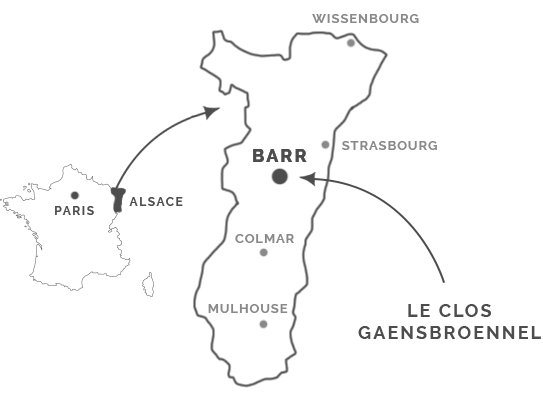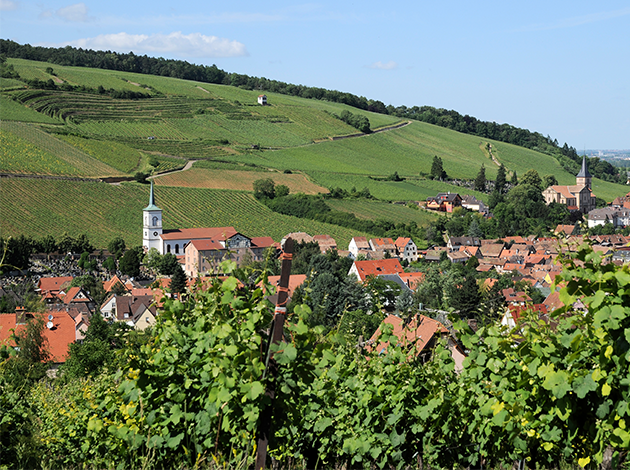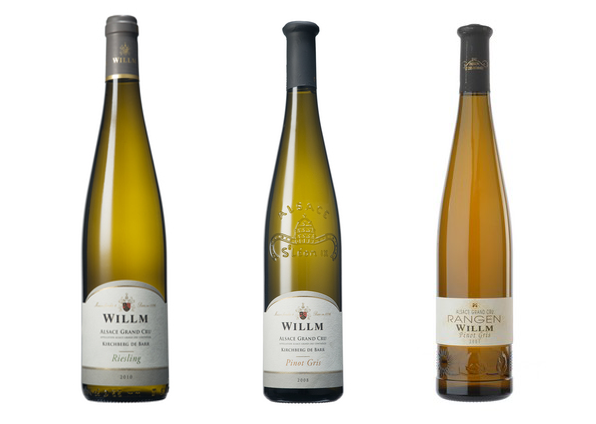Our Vineyard
The grand cru
Kirchberg de barr

The Grand Cru Kirchberg appellation dominates the Barr region, sprawling behind the Maison Willm. These hills, known and recognized since 1760, are home to the Saint Martin chapel, which is why this land now bears the name “hills of the church” (Kirchberg in Alsatian). The plots of vineyard stretch across the hillside at an average altitude of 240 meters, where we grow our three most emblematic grape varieties: Riesling Kirchberg de Barr, Pinot Gris Kirchberg de Barr, and Gewurztraminer Clos Gaensbrœnnel. The region’s marl-limestone terroir lends these wines their unique quality, while the steep grounds give the grapes their unparalleled expression.

A GEOLOGICALLY COMPLEX TERROIR
Wine lovers are well aware that the Grands Crus are born from Grands Terroirs and over the centuries this region has made all the formations emerge, from primary to quartenary. The sea filled what now corresponds to the Upper Rhine Graben. The rocks have been enriched with numerous sedimentary layers of limestone and marl. Then, marine and river deposits, erosion and successive collapses brought complexity to the soil. The Kirchberg of Barr therefore covers a soil composed of thick deposits of clays and calcareous pebbles. The association of marls with limestone brings a balanced richness to the vines which gives the wines of the Kirchberg of Barr their mineral and elegant notes.
A FAVORABLE MICRO-CLIMATE
The Grand Cru Kirchberg de Barr appellation is located east of the Massif du Champ du Feu, on a hill below the Vosges overlooking Barr. The vineyard stretches out across the slope, with an incline up to 30°! With its south-east exposition and high altitude that ranges from 220 to 350m, the Grand Cru Kirchberg de Barr vineyard has ideal sun exposure. Temperatures are typically higher on the hill, with cold air flowing downwards to the surrounding areas.
The marl-limestone, rocky terroir captures and stores heat to be reused when the temperature drops at night. The south-southeast orientation shelters the vines from cold winds coming in from the north. The combination of these elements make this Grand Cru terroir optimal for slow, consistent grape ripening.

WHICH GRAPES GROW BEST?
The marl-limesetone soil combined with the coolness of the terroir and its ideal sun exposure make the Barr vineyard optimal for growing the Gewurztraminer varietal. These grapes develop with aromas of ripe, candied citrus fruits and subtly spiced floral notes that bring freshness and balance to the wine. Two other emblematic Grand Cru grapes grow on these Alsatian vineyard: Riesling and Pinot Gris. The Kirchberg de Barr Riesling reveals spring flower aromas with subtle mineral notes and hints of grapefruit. The Pinot Gris boasts an expressive bouquet and brings structure and liveliness to the wine.
OUR WINE STYLES
It is the particularity of the region’s terroir that gives the wines their surprising, unique bouquets. The Grands Crus of Kirchberg de Barr develop different tasting notes over time. Generally speaking, the marl and limestone terroirs are suitable for producing long-lasting wines; with their delicate fruity notes and subtle spice aromas, theses wines take on a special quality with aging.
